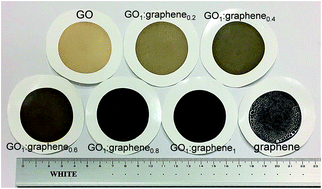Graphene-induced tuning of the d-spacing of graphene oxide composite nanofiltration membranes for frictionless capillary action-induced enhancement of water permeability†
Abstract
While dispersing graphene in water is a formidable challenge, π–π stacking between graphene oxide (GO) and graphene is known to enable the dispersion of graphene in water. In this work, graphene-induced tuning of the d-spacing in GO composite membranes was performed by pressure-assisted self-assembly on a polysulphone inactive support. The physicochemical properties of the GO–graphene membranes were examined using numeric techniques, and the surface charges and hydrophilicities of the surfaces of GO–graphene membranes with different relative compositions of graphene were assessed. The incorporation of graphene into the GO layers was effective in inhibiting the swelling effect in the wet state; the different GO–graphene composite membranes also exhibited water permeability and salt rejection. The GO1graphene0.8 composite membrane demonstrated a water flux of 36 LMH; salt rejection values of 88.3% (sodium chloride), 91.03% (magnesium chloride), 97.6% (magnesium sulphate) and 98.26% (sodium sulphate); and a minimal free volume. Hence, this sample is considered the optimal membrane. GO-incorporated graphene influences membrane performance by converting the Donnan effect to the molecular sieve mechanism. The GO–graphene composite membranes were compared via theoretical and experimental studies.



 Please wait while we load your content...
Please wait while we load your content...